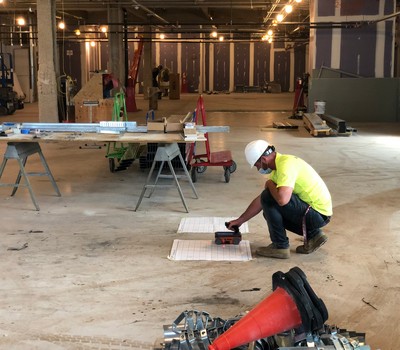Elevate Your Building And Construction Refine With the Strategic Insights of Concrete Scanning for Boosted Performance
One such technology that has actually revolutionized the building market is concrete scanning. By taking advantage of the critical insights given by concrete scanning, building specialists can open a world of improved performance and streamlined processes.

Benefits of Concrete Scanning
Enhancing task effectiveness and safety and security, concrete scanning uses a non-destructive technique for spotting surprise items within concrete frameworks. By utilizing modern technologies such as ground-penetrating radar (GPR) and concrete x-ray imaging, construction groups can accurately situate rebar, post-tension cable televisions, electrical channels, and other obstructions prior to drilling, cutting, or coring into concrete.
The benefits of concrete scanning are various. Building sites can be complex settings, and knowing what exists below the surface area can prevent injuries and accidents.
Furthermore, concrete scanning promotes overall job effectiveness by stopping and simplifying workflows rework. By recognizing possible issues early on, groups can adjust their strategies proactively, saving time and sources in the future. Essentially, the adoption of concrete scanning technologies is a strategic financial investment that pays rewards in terms of cost-effectiveness, safety and security, and productivity.
Innovation Assimilation for Efficiency
Concrete scanning's capability to simplify workflows and enhance task efficiency can be more maximized with strategic integration of sophisticated modern technologies. By integrating Structure Info Modeling (BIM) software application into concrete scanning procedures, building and construction teams can attain a greater level of precision and coordination. BIM allows for the creation of 3D designs that provide in-depth insights into the job, enabling much better decision-making and minimizing the likelihood of errors. In addition, the assimilation of Enhanced Fact (AR) technology with concrete scanning can improve on-site visualization, allowing job supervisors and employees to overlay digital information onto the physical environment in actual time. This can help with extra accurate positioning of aspects and boost communication among group participants. In addition, the use of drones for aerial studies along with concrete scanning can expedite information collection and analysis, allowing faster decision-making and progression tracking. Generally, the calculated assimilation of these modern technologies can substantially increase effectiveness and performance in building and construction tasks.
Avoiding Expensive Mistakes
Just how can meticulous focus to information during concrete scanning procedures help building groups in preventing pricey errors? Concrete scanning plays an essential role in identifying possible concerns before they escalate into costly errors. By utilizing innovative scanning technologies such as Ground Permeating Radar (GPR) and electro-magnetic induction, construction groups can precisely discover rebar, utilities, voids, and other obstructions within concrete frameworks. This degree of precision makes it possible for task managers to make enlightened choices concerning the design and design of their building strategies, lowering the danger of unintended damage to important infrastructure throughout the structure process. Additionally, concrete scanning aids in ensuring structural stability by determining weaknesses or problems in the concrete very early on, permitting prompt repair services and adjustments. By proactively resolving these issues, construction teams can prevent costly errors such as rework, hold-ups, or safety dangers that might arise from forgotten discrepancies in the concrete structure. Inevitably, purchasing detailed concrete scanning procedures verifies to be an affordable approach in the lengthy run, conserving both time and resources while boosting general project performance read and high quality.
Enhancing Project Administration
Careful focus to detail during concrete scanning refines not just assists in staying clear of expensive mistakes but likewise lays a strong foundation for efficient task management in building and construction ventures. By including concrete scanning modern technology right into project management approaches, building and construction groups can improve workflows, enhance interaction, and ensure that jobs stay on track.
Concrete scanning offers beneficial understandings into the architectural honesty of existing elements, permitting project supervisors to make educated choices concerning style adjustments or building sequences. This positive method decreases the risk of unanticipated delays or remodel, eventually conserving time and sources. Furthermore, the information acquired from concrete scanning can be integrated into Structure Info Modeling (BIM) platforms, enabling real-time collaboration and coordination amongst different stakeholders.
In addition, concrete scanning assists task supervisors identify possible risks or obstacles prior to they escalate right into bigger problems, promoting a more secure workplace for all involved. With improved visibility and accuracy provided by concrete scanning innovation, job supervisors can successfully intend, keep track of, and carry out building and construction jobs with better performance and self-confidence.
Maximizing Performance
To boost productivity in construction jobs, applying reliable techniques and making use of innovative technologies is essential. Maximizing performance entails simplifying processes, enhancing source allocation, and reducing downtime. One vital aspect of maximizing efficiency is with the adoption of concrete scanning modern technology. By making use of ground-penetrating radar (GPR) and various other scanning approaches, building groups can accurately locate rebar, channels, and other subsurface elements, decreasing the threat of costly mistakes and delays during excavation and boring.
Furthermore, embracing Building Information Modeling (BIM) software program can significantly enhance productivity by producing detailed 3D versions that boost project visualization and control among different next page trades. BIM permits better clash detection, making it possible for issues to be determined and solved prior to building even begins, conserving time and resources in the long run.
Executing a lean building and construction method, which concentrates on removing waste and enhancing effectiveness throughout all job phases, is one more effective approach for optimizing performance. By fostering cooperation, interaction, and continuous improvement, building groups can function much more cohesively towards achieving task goals in a structured and efficient way.
Conclusion
To conclude, the calculated application of concrete scanning in the construction procedure uses numerous advantages, including enhanced efficiency, expense financial savings, improved job management, and enhanced efficiency. By incorporating this innovation, building teams can stay clear of expensive why not try this out mistakes, simplify their operations, and optimize their total project result. Concrete scanning is an important tool that can raise the construction process and result in more successful and effective outcomes.
